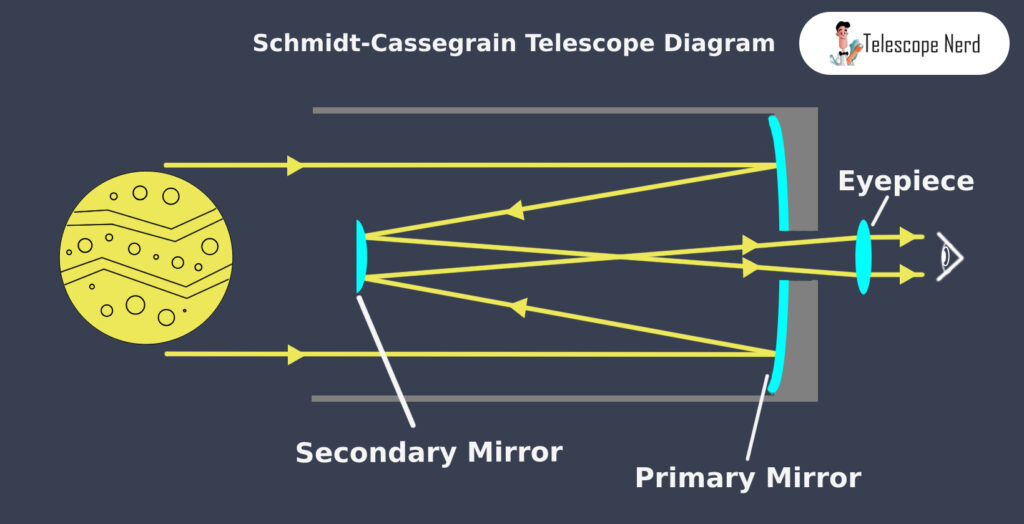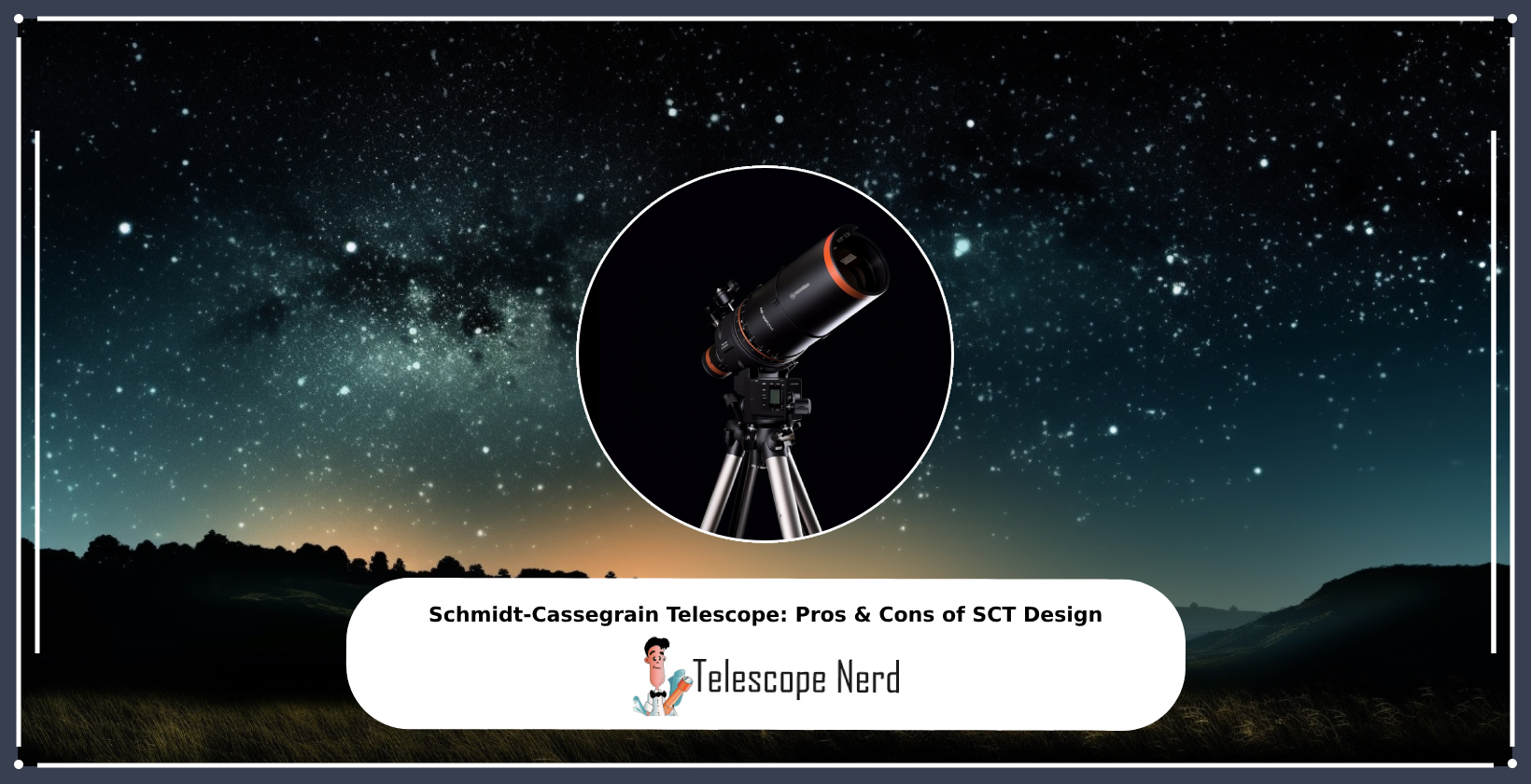Schmidt-Cassegrain Telescope: Pros & Cons of SCT Design
The Schmidt-Cassegrain Telescope (SCT) is a compound telescope that combines mirrors and lenses to create an image. The SCT uses a spherical primary mirror, a secondary mirror, and a corrector plate to correct spherical aberration, resulting in a compact and adaptable instrument.
The SCT is known for its portability and versatility among both amateur astronomers and research institutions. The SCT design, which folds the optical path, makes it particularly suitable for mobile observatories. Despite its compact size, it’s known for delivering sharp images across various viewing conditions, from planetary observation to deep-sky ventures.
While the SCT offers a blend of wide-field and high-power observation, it’s not without its challenges. Optically, the SCT exhibits imperfections like coma or chromatic aberration in certain models. Compared to the Maksutov-Cassegrain (MAK) telescope, the SCT generally has a faster focal ratio and broader field of view, though the Mak offers superior planetary contrast.
The SCT captures light using a corrector plate and channels it to the primary mirror, which then reflects it to the secondary mirror. This light is then focused through the primary mirror to the eyepiece. Various SCT models cater to different needs, from astrophotography to powerful light-gathering abilities. It’s essential to understand these nuances to select the best SCT for specific observational goals.
What Are the Pros & Cons of Schmidt-Cassegrain Telescope Design?
The Schmidt-Cassegrain Telescope (SCT) balances the advantages of both reflectors and refractors. Their unique blend of features positions them as one of the preferred choices for observers spanning the spectrum from hobbyists to professionals. The four primary advantages of the SCT are listed below.
- Portability
- Versatility
- Corrected Optical System
- Broad User Base
The SCT is notably portable because of its folded optical path, achieved by using both a primary and a secondary mirror. This design ensures that the telescope is portable without sacrificing its optical capabilities.
SCTs are renowned for their versatility across various viewing conditions, from planetary observation to deep-sky exploration. This is largely due to the combination of their aperture sizes and their ability to accommodate a range of eyepieces, anywhere from 4 to 40mm.
One of the main features of the SCT is its corrector plate. This thin, aspheric lens at the front of the telescope corrects for spherical aberration, ensuring that the images produced are sharp and free from specific optical distortions.
The SCT’s combination of portability, versatility, and optical prowess makes it a popular choice not just among amateur stargazers but also in advanced research institutions.
While the SCT has been revolutionary in many aspects, no telescope design is without its challenges. The inherent characteristics and design choices of SCTs introduce 4 drawbacks, shared below.
- Optical Imperfections
- Cooling Time
- Maintenance.
- Cost
While the SCT corrects for spherical aberration with its corrector plate, some models still exhibit optical imperfections like coma or chromatic aberration, especially near the edges of the field of view.
SCTs, due to their closed design and the presence of the corrector plate, often require more extended periods to reach thermal equilibrium with the outside environment, which affects initial viewing sessions.
The SCT’s open tube design, while reducing overall weight, means that the internal mirrors accumulate dust or other particulates, necessitating occasional cleaning.
The combination of mirrors and a corrector plate makes SCTs more expensive to produce than simpler designs. For example, a 10-inch SCT typically costs between $1,000 and $3,000 (€920.94 and €2,762.80), while a similar Dobsonian, or other comparable telescope, generally ranges from $500 to $1500 (€460.95 to €1,382.85) for the same aperture.
While SCTs often provide faster focal ratios, potentially broader fields of view, and come at a more affordable price point, the Maksutov-Cassegrain (MAK) generally offers superior contrast. This increased contrast is primarily due to its different corrector plate design and slower focal ratios. Choosing between them often hinges on specific observational preferences and priorities.
How Does the Schmidt-Cassegrain Compare to the Maksutov Telescope?
The Maksutov telescope (Mak) is a type of compound or catadioptric telescope that combines both refractive and reflective elements. The Mak’s defining feature is the thick meniscus corrector lens positioned at the telescope’s front. This lens compensates for the spherical aberration that distorts the resulting images. Once the light permeates through this lens, it’s reflected by a primary mirror and redirected by a secondary mirror toward the eyepiece.
The Maksutov telescope encompasses a wide range of designs. One of the most predominant subtypes is the Maksutov-Cassegrain, due to its incorporation of the secondary mirror to usher light towards the eyepiece.
While both the Schmidt-Cassegrain telescope (SCT) and Mak utilize the same foundational operation, each telescope caters to unique observational goals. The Maksutov has superior contrast, making it a top contender for astronomers eager to delve into planetary details. It often trumps the SCT when it comes to discerning intricate details on planets or the moon. However, the SCT counters with its broader field of view, attributed to its typically faster focal ratios. The wide field of view and faster optics make the SCT a preferred choice for many looking to survey vast celestial territories or engage in astrophotography.
Both designs are beneficial in certain observational scenarios, but they each have their own challenges. The thickness of the Maksutov’s corrector lens lead to longer acclimation times in fluctuating temperatures, delaying viewing sessions. The SCT, on the other hand, occasionally suffers from optical imperfections, such as coma on its edges.
The SCT and Mak are both used by mounting, aiming, and focusing its optics. However, the intricacies in their designs will result in different experiences. The Maksutov, with its weightier corrector plate, often demands more patience, especially during setup in varied temperatures. The SCT, renowned for its expansive field of view, is apt for those eager to explore larger celestial swathes or capture the cosmos through astrophotography. Conversely, the high contrast of the Mak makes it ideal for lunar and planetary gazers.
Both telescopes work by collecting light via their primary optical elements, whether it’s the SCT’s corrector plate or the Mak’s meniscus lens. This light is then navigated towards the primary mirror, which then bounces it to the secondary mirror. This secondary mirror, in turn, focuses the light out towards the eyepiece.
How Does a Schmidt-Cassegrain Telescope Work?
The Schmidt-Cassegrain telescope works by using both lenses and mirrors to focus light and create an image. The diagram depicts a telescope with distinct parts, each contributing to its functionality. The light first enters the telescope through the aperture. As it progresses, the light encounters the primary mirror, which reflects it towards a specific point. Depending on the number of mirrors or lenses incorporated, there is often further reflection or refraction. The number of these optical elements will vary, and their quantity will influence the telescope’s light path and overall performance.

The incoming light first passes through the corrector plate at the front of the optical tube. The corrector plate is an aspheric lens at the front of the telescope, which corrects for spherical aberration. Light is then captured by the concave primary mirror at the back of the optical tube. The primary mirror focuses the light, directing it toward the secondary mirror at the front of the optical tube.
The secondary mirror is convex, meaning it bends light towards a focal point, bringing the image into focus. The secondary mirror concentrates this light, redirecting it to the eyepiece through an opening in the primary mirror. After being focused by these optical elements, the light reaches the eyepiece, where the observer views a magnified image.
The foundational design of the SCT involves the primary and secondary mirror, there are types of the SCT design that incorporate additional mirrors or lenses. The inclusion or exclusion of these elements leads to modifications in the path of light, which influence the final image’s clarity and the telescope’s overall performance.
Is the Schmidt-Cassegrain Telescope the Best Type for Beginners?
No, the Schmidt-Cassegrain Telescope (SCT) is not the best type for beginners due to the cost and complexity of use. Of the primary telescope types, the best will depend on what the individual wants to achieve and their budget. The SCT is a versatile and popular telescope design, known for its compact design and adaptability to various types of observations. It combines the features of both refractors and reflectors, giving it a broad range of capabilities.
However, SCTs tend to be more expensive than simple refractors or Newtonian reflectors, which is more suitable for someone just starting out. Moreover, while they offer a lot of functionality, this also introduces complexity that is overwhelming for many newcomers. For beginners learning the basics, simpler and more affordable designs are ideal. Once familiar with these basics, consider investing in more advanced telescopes like the SCT to optimize the observational experience.
What are the Best Schmidt-Cassegrain Telescopes?
The best Schmidt-Cassegrain Telescopes (SCTs) are determined by their intended use, performance, build quality, and popularity.
For general stargazing, an SCT that offers a good balance between magnification, aperture size, and portability is generally ideal. For astrophotography, SCTs with features like tracking capabilities, compatibility with camera mounts, and optical clarity become paramount.
A high-performing SCT will offer clear, crisp images with minimal aberrations. This typically comes down to the quality of the optics, the precision of the mirrors, and the overall alignment of the telescope’s components. Good performance are gauged by the telescope’s ability to resolve fine details, especially on planets and the moon.
The best SCTs are built to last. This includes not just the quality of the optics, but also the construction of the telescope tube, mount, and other components. A durable, well-constructed SCT will withstand regular use, resist wear and tear, and maintain its alignment over time.
The most popular SCTs have earned their reputation through consistent performance and user satisfaction. Brands like Celestron and Meade have produced SCT models that are widely recognized and respected in the astronomy community.













